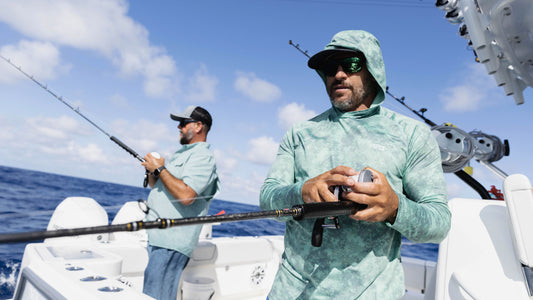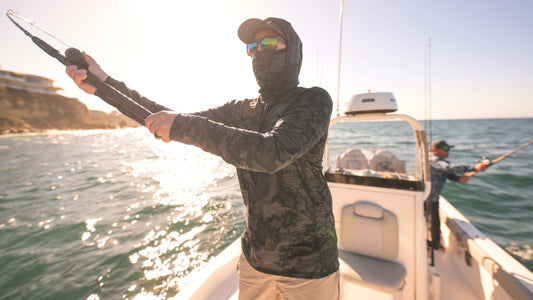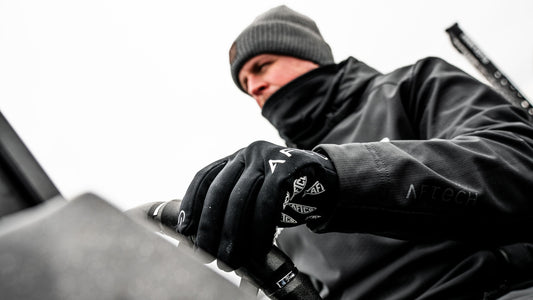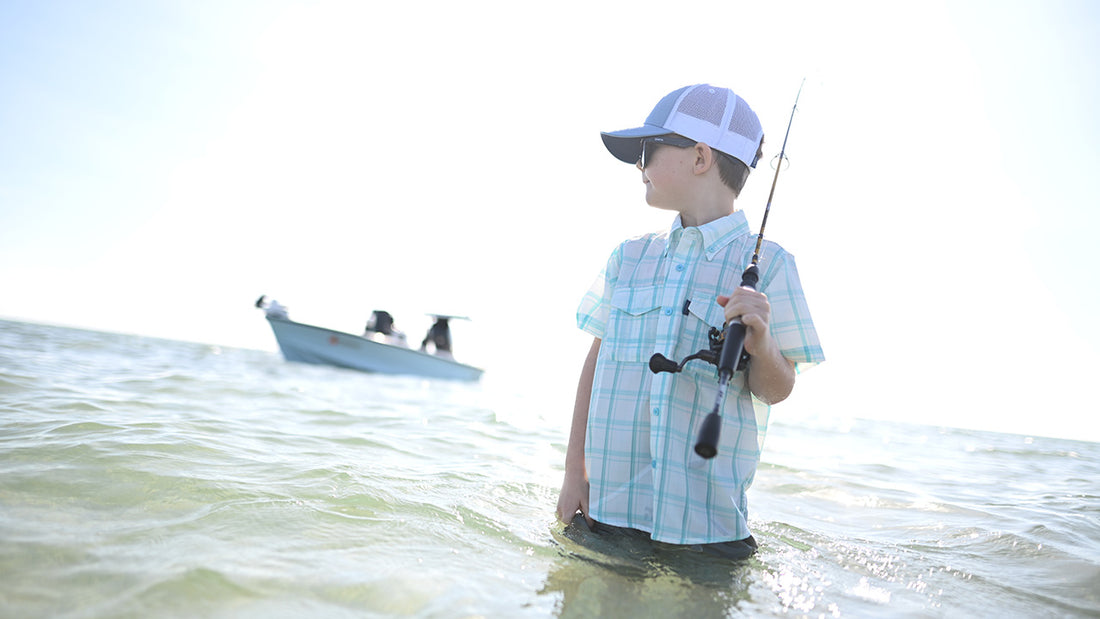
Saltwater Fishing For Beginners
The ocean is full of opportunities for beginner anglers living by the coast. Whether you’re an angler chasing calico bass or yellowtail, our saltwater fishing beginners guide breaks down the basics to help you score a trophy catch. Gear will vary by season, location, and the species you’re targeting. However, these saltwater fishing basics will help you get one step closer to becoming a skilled angler. For more fishing tips, check out our guide to fishing for beginners.

Overview: Beginners Saltwater Gear Set Up
- 7-foot medium heavy rod
- 4000-size reel
- 15 lb. mono
- Live bait or soft plastic (varies based on targeted species)
Saltwater Gear Check: Rod & Reel
Your gear will vary depending on the species you’re targeting. For East Coast anglers, you’re probably targeting stripers, small tarpon, and snooks. Meanwhile, West Coast anglers chase sea bass, surf perch, or halibut. Regardless of location, having the right rod and reel is essential. A good fishing rod for beginners is a 7-foot medium heavy rod with a 4000-size reel and 15 lb. mono. Anglers need heavier lines to land larger fish. Heavier lines give anglers better control while fighting fish, and make it easier to successfully land fish. Saltwater fishing beginners should also start with a saltwater spinning reel. Spinning reels are very versatile and effective for casting, jigging, or trolling
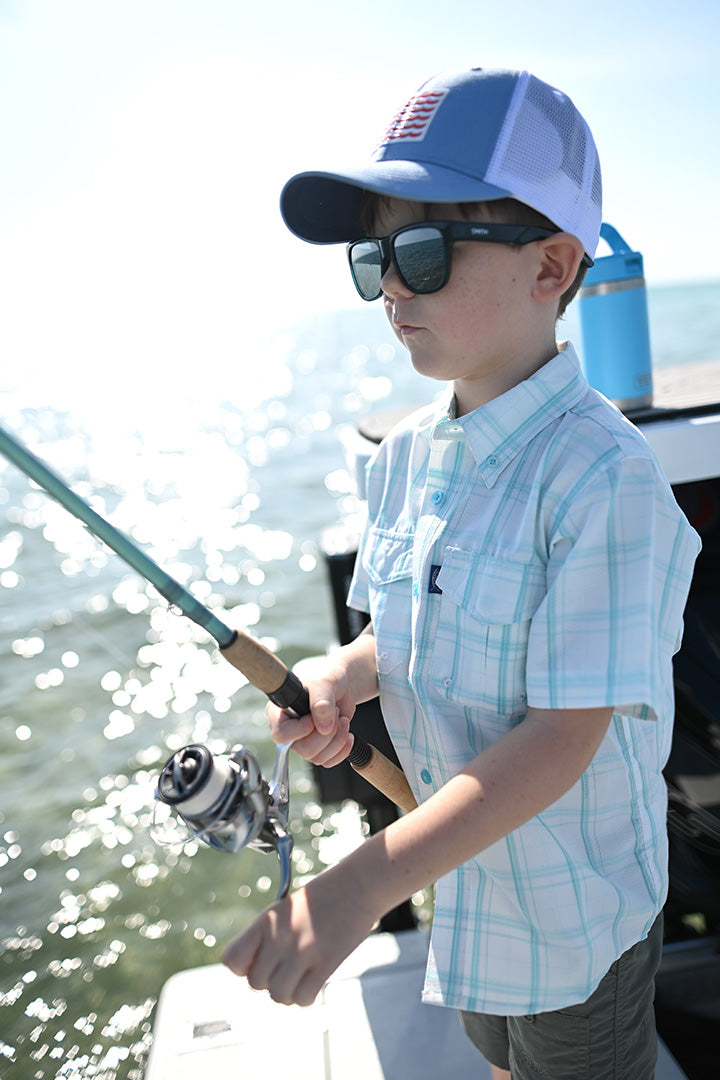

A saltwater spinning reel is the preferred weapon of choice for new anglers.
Saltwater Fishing Line: Getting Started
To complete a saltwater fishing setup for beginners, you must outfit your rod and reel with the right fishing line. Monofilament, often called mono, is easier to cast, helps avoid tangles, and is highly versatile. We recommend starting with 15 lb. monofilament. Mono is strong and water resistant, making it the most popular type of saltwater fishing line. Plan to change out your mono regularly depending on use.
Once you’ve mastered fishing with mono, you can experiment fishing with braid as your mainline with a fluorocarbon leader. A great fluorocarbon we recommend starting with is 15 lb. AFTCO Saiko Pro. Saiko Pro is a 100% custom fluorocarbon fishing line made in Japan for optimum performance. It’s available in two lengths and 15 different pound tests.
Line selection will depend on the target species, water clarity, surrounding structure, and several other factors. To find the best fishing line, consult your local tackle shop and check out Take Me Fishing’s guide on the Best Saltwater Fishing Line Types before hitting the water.
How to Cast a Spinning Reel
Spinning rods are excellent beginner rods because of their ease of use, and versatility. With spinning rods, anglers can target saltwater and freshwater species using different lures and bait. Spinning rods have downward-facing guides and a straight handle that lets line flow freely off the reel. Bails control the flow of the line, and with spinning rods, anglers can feel quick nibbles on the line if they’re jigging, trolling, or casting.
To cast:
- Use your pointer finger to grab and hold the line while opening the bail.
- Pull the rod back to rotate over your dominant shoulder and swing forward, pointing the rod at your desired target.
- As you swing the rod, release the line with your finger.
Finding your rhythm to maximize casting distance while maintaining accuracy will take practice. Click here to see a spinning rod cast in action. For general casting tips, check out Take Me Fishing’s guide on how to cast a spinning reel.

Saltwater Fishing Basics: Bait & Lures
With your rod and reel ready, it's time to finish your setup. A unique feature of saltwater fishing is that your geographic location will influence the type of bait you use. For example, if you're trying to catch a striped bass on the East Coast, anglers use live American eels, but this species is only found on the Atlantic Coast. If you're a West Coast angler, striped bass predominantly eat finfish native to the Pacific Ocean. Generally, the best bait to use in saltwater fishing is live bait. Baitfish, shrimp, anchovies, and scad are great options to attract a variety of gamefish. Also, it's best to use a light leader, main line, and hooks when using live bait to avoid putting too much stress on the bait. Live bait is available at your local saltwater tackle store or marina. Ultimately, the best baits for saltwater fishing depend on where you're fishing and the species you're after.
Saltwater Lure Recommendations:
- Bucktail jigs in 3/8oz to 1oz for different depths and current
- Soft plastic swimbait on a jighead
- 3/8oz to 1/2oz with a 4” soft plastic swimbait
- Spoon for casting or jigging
- Hard bait minnow plug - 1/2oz bait in 4”-5” length.
Like with bait, the type of lure you use will depend on the saltwater species you’re targeting. The five lure recommendations above will have anglers covered and well-equipped to land saltwater species, no matter where they're fishing.
AFTCO's saltwater lure collection includes surface lures, lead jigs, and jerkbaits. The Blue Fever Swimmer works great for offshore or inshore fishing. For offshore fishing, this lure entices tuna, yellowtail, and dorado. For inshore fishing, calico bass, snook, and redfish will go for the bite. The Blue Fever Swimmer has excellent side-to-side swimming action and is easy to cast. All AFTCO lures come rigged and ready to fish straight out of the box, and are available in several sizes and colors.

Location Matters Recommendations: Pier, Surf, & Jetties
Pier Fishing
Every day on the water is different. Some days, the fish are biting wide open, while other times you can’t buy a bite. For beginner anglers, piers, rock jetties, and beaches are excellent places to start because they’re free and full of exciting species to catch. In southern California, anglers can catch croakers, bass, perch, mackerel, and even sharks from piers. Start at the end of the pier, where the water is the deepest. At the end of the pier, try to fish on the side where the tide direction is going away from you, and the best time to catch a fish is when there’s a moving tide. Learn more about saltwater pier fishing here.
Surf Fishing
For anglers surf fishing on the beach, check local fishing regulations before heading out because most states require a fishing or shoreline fishing license. Then, stop into your local tackle shop for bait and gear recommendations specific to the species you want to catch. With smaller species like pompano, bluefish, and flounder use shorter rods with lighter gear. Then, use a longer rod outfitted with heavier gear for larger species like red drum or striped bass. Generally, mullet, shrimp, or squid appeal to many fish species, and keep them on ice or in a bait bucket out of the sun. Fishing tackle will vary, but make sure to have extra pyramid sinkers, egg sinkers, and a few teardrop sinkers on hand. Sinkers are helpful because they keep your bait in place during strong tides. Check out more surf fishing tips here.
Jetty Fishing
Whether you’re an angler fishing the jetty from the shore or on a boat in the water, here are our top tips for fishing jetties. Jetties are a prime fishing spot for beginners because they’re full of vegetation, bait, and crab, perfect for gamefish looking for their next meal. Fishing anywhere on the jetty is promising, but the corner pocket where the jetty joins the shoreline, and the jetty tip are two hot spots we recommend. At these two spots, water movement changes constantly with the tides, and there’s no place for baitfish to hide in the rocks, making it a perfect place to strike. Trout and redfish like to hang close to the rocks, so use light setups with live shrimp for bait. For striped bass, use crankbaits. Bring several baits to encourage bites if you’re chasing multiple fish species. Click here to learn more tips for jetty fishing.
Gear Maintenance to Avoid Saltwater Corrosion
Another tip is to perform regular gear maintenance. Fishing rods have several metal components that rust and corrode quickly when exposed to saltwater. To avoid corrosion, a quick freshwater rinse-off will do the trick and keep your gear in top condition. As you rinse your gear, focus on the fishing line guides, and finish by drying your rod and reel off with a soft, absorbent cloth. After that, let your rod and reel air dry. Besides freshwater rinses, there are a variety of anti-corrosion sprays on the market that are effective, too. Taking the time to clean your gear after each trip will keep your gear in top condition.
Other Saltwater Fishing Resources
For saltwater fishing beginners, one of the best ways to learn is from experienced anglers. From guides, to knowledgeable anglers working in your local tackle shop, their expertise can help you avoid frustration and hopefully land some fish. Check out our retailers here to find a local tackle shop near you.
Saltwater fishing guides vary by region, but by using a guide, you can see action and learn firsthand from seasoned anglers. For saltwater anglers in Southern California, check out Coastal Charters, run by Captain Ben Florentino, if you're interested in offshore or inshore fishing. For saltwater anglers in the south, check out Journey South Outfitters guide service based in Venice, Louisiana. Run by Captains Moe and Eric Newman, these saltwater guides are experts in fishing inshore and offshore.
Beyond guides, there are excellent online saltwater fishing communities. Our top recommendations are BD Outdoors on the West Coast, On The Water for anglers in the Northeast, and Salt Strong in the Southeast.
Other resources are local saltwater fishing clubs and saltwater conservation groups. The Coastal Conservation Association (CCA) is the largest saltwater fishing conservation group and does everything from hosting saltwater fishing tournaments to habitat restoration and fishing advocacy. Click here to learn more about AFTCO’s conservation partners and ways to get involved.
Have Fun & Conserve Our Resource
Always pick up your trash and fishing gear before heading out and follow state fishing regulations to keep fish populations strong. Check out our beginner freshwater fishing blog to learn more about freshwater fishing. Best of luck on the water!




